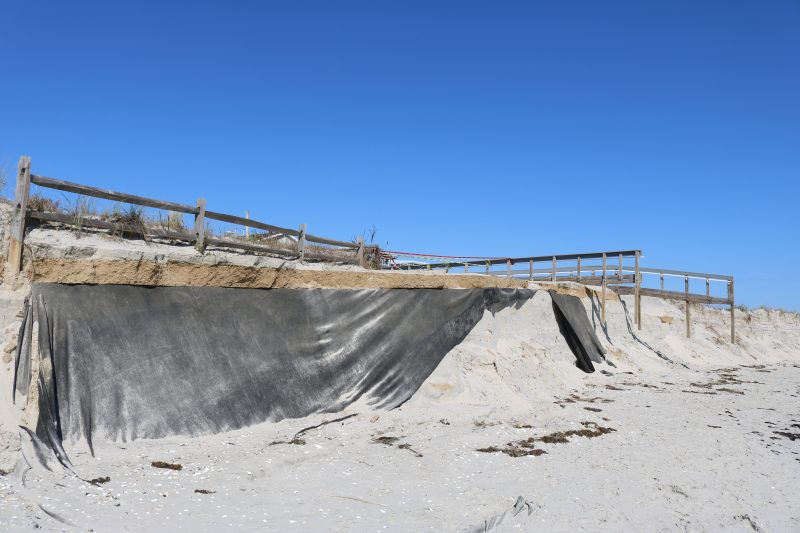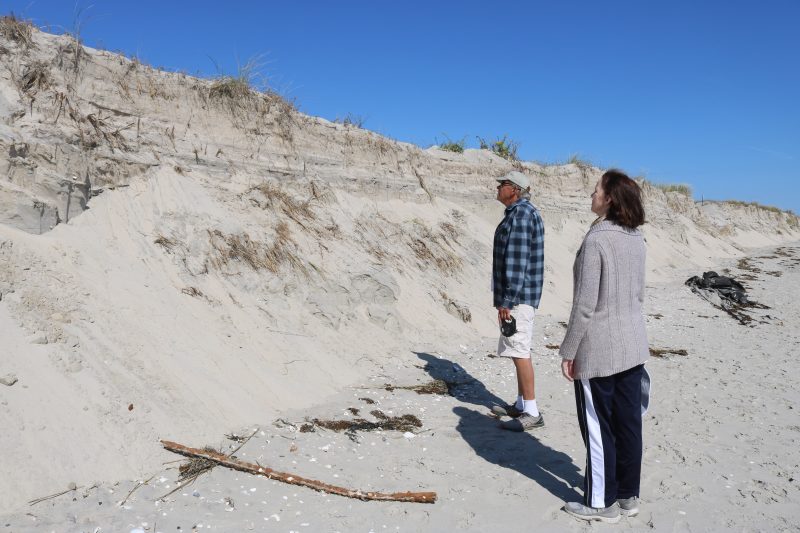
By DONALD WITTKOWSKI
The pathway that Patrick and Mary Beth McKeefery normally take over the dunes to the 85th Street beach now leads to … nowhere.
In a bizarre scene, the pathway’s wood railing hangs precariously above the beach in midair. There is a drop of more than 10 feet down to the beach from the top of the dunes. The pathway, essentially, has become a dead end.
“You used to be able to walk down to the beach. Now, it’s like a 12-foot ledge. It’s a huge difference,” Patrick said while he and Mary Beth carefully inched their way toward the end of the pathway to peer over the edge of the dunes.
Sea Isle City is once again dealing with serious beach and dune erosion that has washed away countless amounts of sand in the Townsends Inlet section of town, at the south end of the island.
The city is waiting for a beach replenishment project by the U.S. Army Corps of Engineers to get underway this fall or winter to restore the eroded shoreline, but in the meantime more and more sand keeps disappearing in Townsends Inlet.
A weeklong pounding of drenching rains, gusty winds and rough surf from Tropical Storm Ophelia in late September was the latest blow. A post-storm survey conducted by the New Jersey Department of Environmental Protection found that some of Sea Isle’s beaches suffered “moderate” erosion.

The beaches between 88th Street and 92nd Street are notoriously vulnerable to erosion during the stormy winter and spring seasons, but this year the dune damage in Townsends Inlet has also extended several blocks north to include streets in the lower 80s.
Patrick and Mary Beth McKeefery, who own a summer vacation home on 85th Street, said they have never seen this much erosion during all the time they’ve live in Townsends Inlet.
“Never has it been more than a foot drop,” Patrick said of the eroded dune face.
Patrick said his family established roots in Sea Isle just after World War II, when his grandmother bought property along 85th Street.
Now, with the end of the pathway at 85th Street washed away by the ocean, the McKeeferys have no other choice but to take another route to the beach.
“You have to get in your car and drive for five blocks,” Mary Beth said.
As a safety measure, the city has blocked off 85th Street and some of the other badly eroded beach pathways with yellow caution tape.

The McKeeferys appeared during a City Council meeting on Tuesday to ask Sea Isle officials whether other factors may be contributing to the beach erosion, in addition to the stormy weather.
They believe sand dredging that was part of a recent beach replenishment project for Avalon may have sucked up a sandbar not far off Sea Isle, contributing to the erosion in Townsends Inlet.
“Why were they pulling sand out of our inlet?” Patrick said.
The McKeeferys said they saw two boat-like sand dredges that were anchored offshore by the sandbar for three to four weeks.
However, Sea Isle Business Administrator George Savastano explained that Avalon’s beach replenishment project did not involve taking sand from the sandbar.
During the winter, Sea Isle hired a contractor to fortify the eroded dunes between 88th and 92nd streets through a process known as “sand harvesting.” Essentially, sand was scrapped from the water’s edge and pushed up against the dunes by earthmovers.
It appears that Tropical Storm Ophelia washed away a large portion of the beach and dunes that had been replenished by the sand harvesting, along with other sections of the shoreline. Some of the dunes in Townsends Inlet have been sheared away by the ocean, leaving mini-cliffs about 20 feet high in some places.
“What really hurt us was a week straight of high tides and rough surf,” Savastano said of Ophelia’s impact.

In an interview after the Council meeting Tuesday, Savastano said it was unlikely that Sea Isle will do any more sand harvesting at this time. But he didn’t completely rule it out. He said he is worried that the sand would simply wash away and it would be “a waste” to place it on the beach during the usually stormy spring season.
“We’ll probably just keep an eye on it,” Savastano said of the erosion.
“We’ll keep it safe,” he added of the city’s efforts to protect homes.
Sea Isle is waiting for the U.S. Army Corps of Engineers to begin a full-scale beach replenishment project in the fall or winter to restore a much-larger stretch of the eroded shoreline.
A contractor for the Army Corps will place 252,000 cubic yards of fresh sand in central Sea Isle from about 29th Street to 53rd Street. Another 388,000 cubic yards of new sands will restore the beach in the south end from about 73rd Street up to Townsends Inlet, Army Corps spokesman Steve Rochette said.
Bids have been opened for the beach replenishment project – which also includes Strathmere and the southern end of Ocean City – and are being evaluated by the Army Corps before a contract is awarded. The bids were significantly higher than the government’s estimate, so the Army Corps is considering its options, Rochette said.








